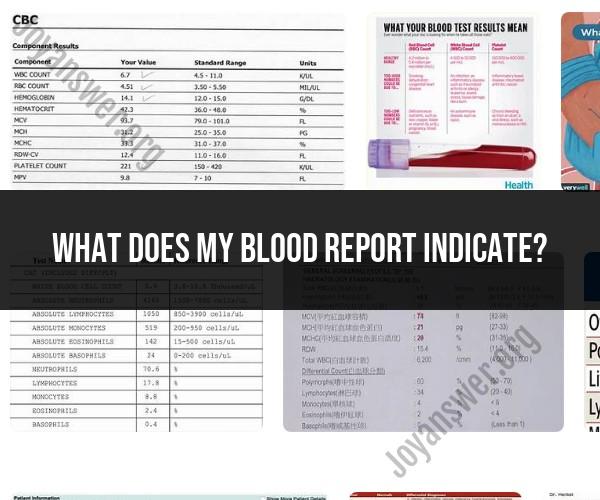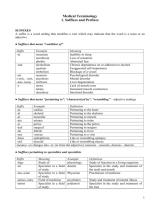What does my blood report indicate?
Understanding Your Blood Report
Your blood report, also known as a blood test or blood panel, provides valuable insights into your overall health and can indicate various aspects of your well-being. It involves the analysis of different components of your blood, and the results can help healthcare professionals assess your health status.
Key Components of a Blood Report
A typical blood report includes information about several key components, including:
- Complete Blood Count (CBC): This measures various blood components such as red blood cells, white blood cells, and platelets. Abnormalities in these values can indicate conditions like anemia, infection, or clotting disorders.
- Lipid Profile: This assesses your cholesterol levels, including LDL (bad) cholesterol, HDL (good) cholesterol, and triglycerides. It provides insights into your cardiovascular health.
- Glucose Levels: This measures your blood sugar levels and helps in diagnosing or monitoring diabetes.
- Liver Function Tests: These evaluate the health of your liver by measuring enzymes and proteins. Abnormalities can indicate liver diseases.
- Kidney Function Tests: These assess your kidney health by measuring creatinine, blood urea nitrogen (BUN), and other markers. Kidney problems can be detected through these tests.
- Electrolyte Levels: Sodium, potassium, calcium, and other electrolytes are assessed to ensure the balance necessary for bodily functions.
- Thyroid Function Tests: These measure thyroid hormone levels, which can indicate thyroid disorders.
- Coagulation Profile: This evaluates blood clotting factors and can identify bleeding disorders or clotting disorders.
Interpreting Your Results
Interpreting your blood report requires the expertise of a healthcare professional, such as a doctor or a lab technician. They will consider your individual medical history, symptoms, and other factors when assessing the results. Normal ranges for various components may vary depending on age, gender, and other factors, so it's crucial to consult a healthcare provider for an accurate interpretation.
Conclusion
Your blood report is a valuable tool for assessing your health. It provides essential information that can help diagnose medical conditions, monitor your health, and guide treatment decisions. Always consult with a healthcare professional to understand the significance of your blood test results and take appropriate actions based on their recommendations.
Deciphering Your Blood Report: What the Numbers Mean
A blood report is a summary of the results of blood tests that have been performed. It can provide a wealth of information about your health, including your blood cell counts, cholesterol levels, blood sugar levels, and kidney function.
Here is a brief overview of some of the most common blood tests and what the results mean:
- Red blood cell count (RBC): RBCs carry oxygen throughout the body. A low RBC count (anemia) can cause symptoms such as fatigue, shortness of breath, and dizziness. A high RBC count (polycythemia) can be caused by dehydration, smoking, or certain medical conditions such as heart disease or lung disease.
- White blood cell count (WBC): WBCs help to fight infection. A high WBC count (leukocytosis) can be a sign of infection, inflammation, or certain types of cancer. A low WBC count (leukopenia) can be caused by certain medications, autoimmune diseases, or viral infections.
- Platelet count: Platelets help the blood to clot. A low platelet count (thrombocytopenia) can increase the risk of bleeding. A high platelet count (thrombocytosis) can increase the risk of blood clots.
- Hemoglobin and hematocrit: Hemoglobin is a protein in red blood cells that carries oxygen. Hematocrit is the percentage of blood that is made up of red blood cells. Low hemoglobin or hematocrit levels can be a sign of anemia. High hemoglobin or hematocrit levels can be caused by dehydration, smoking, or certain medical conditions such as heart disease or lung disease.
- Cholesterol levels: Cholesterol is a fatty substance that is found in the blood. High cholesterol levels can increase the risk of heart disease and stroke.
- Blood sugar levels: Blood sugar levels are regulated by the hormone insulin. High blood sugar levels (hyperglycemia) can be a sign of diabetes or prediabetes. Low blood sugar levels (hypoglycemia) can be caused by certain medications, diabetes, or other medical conditions.
- Kidney function tests: Kidney function tests measure how well your kidneys are working. High levels of creatinine or BUN (blood urea nitrogen) in the blood can be a sign of kidney disease.
Making Sense of Your Blood Test Results
It is important to note that normal blood test results can vary from person to person. Your doctor will review your blood test results and compare them to your individual medical history and risk factors.
If you have any questions about your blood test results, be sure to ask your doctor. They can help you to understand what the results mean and what steps you may need to take to improve your health.
What Your Blood Report Reveals About Your Health
A blood report can provide a lot of information about your health, including:
- Your overall health status: Your blood report can give your doctor a good idea of your overall health status. For example, if you have high blood sugar levels, your doctor may be concerned that you are at risk for developing diabetes.
- Your risk of developing certain diseases: Your blood report can also help your doctor to assess your risk of developing certain diseases, such as heart disease, stroke, and cancer. For example, if you have high cholesterol levels, your doctor may be concerned that you are at risk for developing heart disease.
- The effectiveness of your treatment: If you are being treated for a medical condition, your doctor may order blood tests to monitor the effectiveness of your treatment. For example, if you are taking medication to lower your cholesterol levels, your doctor may order blood tests to see if the medication is working.
Overall, a blood report is a valuable tool that can help your doctor to assess your health and provide you with the best possible care.












